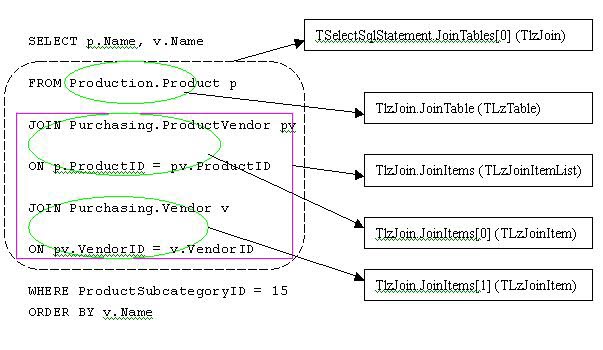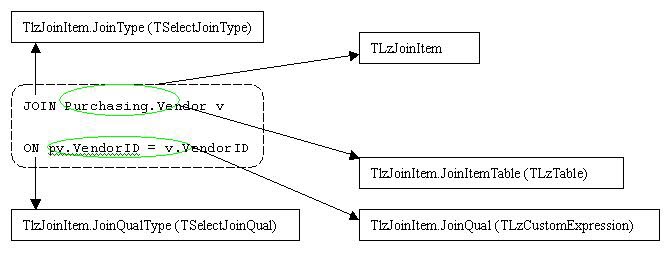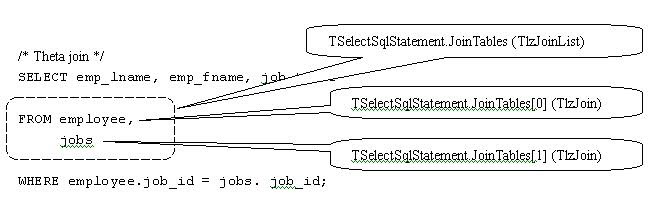From the following 3 diagrams, you can have a better understand of TLzJoin , TLzJoinList, TLzJoinItem, TLzJoinItemList which is used to represent join table in from clause.
You can check TSelectSqlStatement.JoinTables which is type of TLzJoinList to start fetching all those information.



Scenario 1
Select t1.f1 from my.table1 t1,my.table2 t2 where t1.f1 = t2.f1
After parsing this sql, data in TSelectSqlStatement.Tables is:
Tables.Count = 2; Tables[0].TableName = 'table1'; Tables[0].TablePrefix = 'my'; Tables[0].TableAlias = 't1'; Tables[1].TableName = 'table2'; Tables[1].TablePrefix = 'my'; Tables[1].TableAlias = 't2'; And information in TSelectSqlStatement.JoinTables is: JoinTables.Count = 2; JoinTables.items[0].JoinTableType = jttTable; // the collection of join is table : my.table1 JoinTables.items[0].JoinTable = Tables[0];//my.table1 JoinTables.items[0].JoinItems.count = 0; JoinTables.items[1].JoinTableType = jttTable; // the collection of join is table : my.table1 JoinTables.items[1].JoinTable = Tables[1];//my.table2 JoinTables.items[1].JoinItems.count = 0;
Scenario 2
Select t1.f1 from my.table1 t1 join my.table2 t2 on t1.f1 = t2.f1
After parsing this sql, data in TSelectSqlStatement.Tables is:
Tables.Count = 2; Tables[0].TableName = 'table1'; Tables[0].TablePrefix = 'my'; Tables[0].TableAlias = 't1'; Tables[1].TableName = 'table2'; Tables[1].TablePrefix = 'my'; Tables[1].TableAlias = 't2';
everything is the same as scenario 1, Now, check the information in JoinTables:
JoinTables.Count = 1; JoinTables.items[0].JoinTableType = jttTable; // the collection of join is table : my.table1 JoinTables.items[0].JoinTable = Tables[0];//my.table1 JoinTables.items[0].JoinItems.count = 1; JoinTables.items[0].JoinItems[0].JoinItemTableType = jttTable;//the collection of this joinitem is table:my.table2 JoinTables.items[0].JoinItems[0].JoinItemTable = my.table2; JoinTables.items[0].JoinItems[0].JoinType = sjtjoin; JoinTables.items[0].JoinItems[0].JoinQualType = sjqOn; JoinTables.items[0].JoinItems[0].JoinQual = AEXPRESSION ; //a custom expressoin point to t1.f1 = t2.f1
Scenario 3
select t1.f1 from my.table1 t1 join (my.table2 t2 left join my.table3 t3 on t2.f1 = t3.f1) as joinalias1 on t1.f1 = t2.f1;
After parsing this sql, data in TSelectSqlStatement.Tables is:
Tables.Count = 3; Tables[0].TableName = 'table1'; Tables[0].TablePrefix = 'my'; Tables[0].TableAlias = 't1'; Tables[1].TableName = 'table2'; Tables[1].TablePrefix = 'my'; Tables[1].TableAlias = 't2'; Tables[2].TableName = 'table3'; Tables[2].TablePrefix = 'my'; Tables[2].TableAlias = 't3';
Now check the data in JoinTables:
JoinTables.Count = 1; JoinTables.items[0].JoinTableType = jttTable; // the collection of join is table : my.table1 JoinTables.items[0].JoinTable = Tables[0];//my.table1 JoinTables.items[0].JoinItems.count = 1; JoinTables.items[0].JoinItems[0].JoinItemTableType = jttJoin;//the collection of this joinitem is join JoinTables.items[0].JoinItems[0].JoinItemJoin = AJoin; // ajoin point to (my.table2 t2 left join my.table3 t3 on t2.f1 = t3.f1) as joinalias1 JoinTables.items[0].JoinItems[0].JoinType = sjtjoin; JoinTables.items[0].JoinItems[0].JoinQualType = sjqOn; JoinTables.items[0].JoinItems[0].JoinQual = AEXPRESSION ; //a custom expressoin point to t1.f1 = t2.f1 JoinTables.items[0].JoinItems[0].JoinItemJoin.JoinTableType = jttTable; JoinTables.items[0].JoinItems[0].JoinItemJoin.JoinTable = Tables[1]; //my.table2 JoinTables.items[0].JoinItems[0].JoinItemJoin.Alias = joinalias1 JoinTables.items[0].JoinItems[0].JoinItemJoin.AliasWithAs = true; JoinTables.items[0].JoinItems[0].JoinItemJoin.NestedLevel = 1; JoinTables.items[0].JoinItems[0].JoinItemJoin.JoinItems.count = 1; JoinTables.items[0].JoinItems[0].JoinItemJoin.JoinItems[0].JoinItemTableType = jttTable; JoinTables.items[0].JoinItems[0].JoinItemJoin.JoinItems[0].JoinItemTable = Tables[2]; //my.table3 JoinTables.items[0].JoinItems[0].JoinItemJoin.JoinItems[0].JoinType = sjtleft; JoinTables.items[0].JoinItems[0].JoinItemJoin.JoinItems[0].JoinQualType = jqtOn; JoinTables.items[0].JoinItems[0].JoinItemJoin.JoinItems[0].JoinQual = AEXPRESSION ; //a custom expressoin point to t2.f1 = t3.f1
Scenario 4
select t1.f1 from my.table1 t1 right join ((my.table2 t2 left outer join my.table3 t3 on (t2.f1 = t3.f2)) left join (my.table4 t4 full outer join my.table5 t5 on (t4.f1 = t5.f1)) t4alias on (t4.b1 = t2.c1)) on (t1.a1 = t3.b3);
After parsing this sql, data in TSelectSqlStatement.Tables is:
Tables.Count = 5; Tables[0].TableName = 'table1'; Tables[0].TablePrefix = 'my'; Tables[0].TableAlias = 't1'; Tables[1].TableName = 'table2'; Tables[1].TablePrefix = 'my'; Tables[1].TableAlias = 't2'; Tables[2].TableName = 'table3'; Tables[2].TablePrefix = 'my'; Tables[2].TableAlias = 't3'; Tables[3].TableName = 'table4'; Tables[3].TablePrefix = 'my'; Tables[3].TableAlias = 't4'; Tables[4].TableName = 'table5'; Tables[4].TablePrefix = 'my'; Tables[4].TableAlias = 't5';
Now, check the data in JoinTables:
JoinTables.Count = 1; JoinTables.items[0].JoinTableType = jttTable; JoinTables.items[0].JoinTable = Tables[0]; //my.table1 JoinTables.items[0].JoinItems.count = 1; JoinTables.items[0].JoinItems[0].JoinType = sjtrightjoin; JoinTables.items[0].JoinItems[0].JoinQualType = sjqOn; JoinTables.items[0].JoinItems[0].JoinQual = AEXPRESSION ; //a custom expressoin point to t1.a1 = t3.b3 JoinTables.items[0].JoinItems[0].JoinItemType = jttJoin; JoinTables.items[0].JoinItems[0].JoinItemJoin = AJoin; // ((my.table2 t2 left outer join my.table3 t3 on (t2.f1 = t3.f2)) left join (my.table4 t4 full outer join my.table5 t5 on (t4.f1 = t5.f1)) t4alias on (t4.b1 = t2.c1)) AJoin.NestedLevel = 1; AJoin.JoinTableType = jttJoin; AJoin.JoinJoin = ASubJoin; //(my.table2 t2 left outer join my.table3 t3 on (t2.f1 = t3.f2)) ASubJoin.NestedLevel = 1; ASubJoin.JoinTableType = jttTable; ASubJoin.JoinTable = Tables[1]; //my.table2 ASubJoin.JoinItems.count = 1; ASubJoin.JoinItems.items[0].JoinType = sjtleftjoin; ASubJoin.JoinItems.items[0].JoinQualType = jtqon; ASubJoin.JoinItems.items[0].JoinQual = AExpression;//t2.f1 = t3.f2 ASubJoin.JoinItems.items[0].JoinItemTableType = jttTable; ASubJoin.JoinItems.items[0].JoinItemTable = Tables[2]; //my.table3 AJoin.JoinItems.count = 1; AJoin.JoinItems.items[0].JoinTableType = jttJoin;//again, this is a join AJoin.JoinItems.items[0].JoinJoin = ASub2Join;//(my.table4 t4 full outer join my.table5 t5 on (t4.f1 = t5.f1)) t4alias ASub2Join.Alias = t4alias; ASub2Join.NestedLevel = 1; ASub2Join.JoinTableType = jttTable; ASub2Join.JoinTable = Tables[3]; //my.table4 ASub2Join.JoinItems.count = 1; ASub2Join.JoinItems.items[0].JoinType = sjtfullOuter; ASub2Join.JoinItems.items[0].JoinQualType = jtqon; ASub2Join.JoinItems.items[0].JoinQual = AExpression;//t4.f1 = t5.f1 ASub2Join.JoinItems.items[0].JoinItemTableType = jttTable; ASubJoin.JoinItems.items[0].JoinItemTable = Tables[4]; //my.table5 AJoin.JoinItems.items[0].JoinType = sjtleftouter;//left join AJoin.JoinItems.items[0].JoinQualType = sjqOn; AJoin.JoinItems.items[0].JoinQual = sjqOn;// t4.b1 = t2.c1